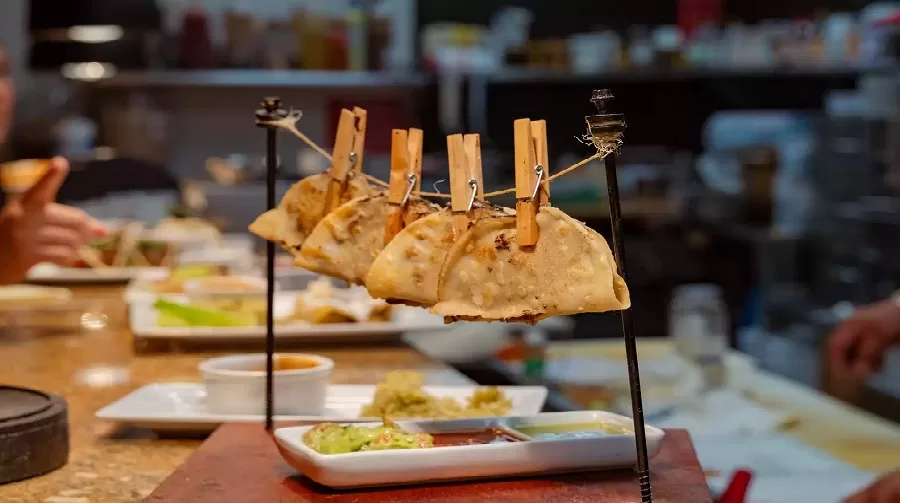Food & Beverage
4 Food Trends Shaping the Future

- The Unilever Future Menus 2025 report elaborates on four major culinary trends – Borderless Cuisine, Street Food Couture, Culinary Roots, and Diner Designed – signifying a huge shift in the industry towards innovation, sustainability, and personalisation.
- These worldwide consumer and chef insights motivate chefs to combine cultures and local ingredients, raise street food to gourmet standards, and provide personalised dining experiences to satisfy changing food consumption habits.
Innovation and sustainability will always reign supreme in gastronomy, and as such, chefs and restaurants will have to adapt, continuously evolving with the diner’s palate one step ahead. Unilever Food Solutions has just released the third edition of the Future Menus 2025 report, an exhaustive guide examining which significant trends are transforming menus across the globe. The research behind the report is immense and includes 312 million online searches and 1,100 interviews with chefs worldwide; trends that are said to be affecting the food culture today are fourfold: Borderless Cuisine, Street Food Couture, Culinary Roots, and Diner Designed. These trends truly reflect the happenings in the culinary realm, but they also give chefs and restaurateurs a chance to rethink their approach to innovation, costs, and sustainable dining.
Trend 1: Borderless Cuisine.
A trend that celebrates a coming-together of world cultures is the coming-together of culinary traditions across the world. In many cases, that is through aspects of multiculturalised cuisine codes pertinent to a specific chef’s background. Techniques, flavours, and identities are altogether different in that they are fused and recombined into something completely new. Participant Santiago Lastra described an avocado-less guacamole with hemp seeds and fermented gooseberry juice at the Future Menus 2025 exhibition in Amsterdam: “When you leave your country, you remember that you’re no longer an ambassador of your culture-to-be… The best recipes were created at times when the world was much less connected than today.” Borderless cuisine is what this spirit defines: chefs harnessing local ingredients and global creative attributes.
For example, spicy Asian glazed fried chicken with waffles and maple mayonnaise is one item on display at the gala opening event of Future Menus on the global level in 2025. An even better example of such fusion was ramen salad, foam, and sweet-and-sour hollandaise. These creations highlight how chefs are pushing boundaries while staying rooted in authenticity, as noted by Deepak Subramanian, President and Managing Director of Unilever Food Solutions North America: “Chefs from our network are working to blend techniques, identities, and experiences to create something entirely new but still rooted in authenticity.”
The report further indicates Latin American and Asian cuisines as the fastest-growing suppliers for global interest in culinary activities, a sign of the rise in cross-cultural flavours. This will push chefs to innovate more indigenous ingredients and participate in digital recipe sharing, shaping a diverse culinary field.
Trend 2: Street Food Couture
Street Food Couture has taken street food from the sidewalk to the refined dining table, a process popularly termed “affordable luxury”. It is a trend attributed mainly to Generation Y, who clamour for truth in eating at a price with “good” flavours. “Chefs are addressing a huge demand for informal formats that don’t compromise on quality,” Ximena Hernandez, head of marketing at Unilever Food Solutions, notes. Consider this feature: a Korean dakbokkeumtang-glazed fermented chilli paired with a cheesecake equivalent filled with guava coulis; both dishes are part of a Future Menus 2025 event staged at the Westergas Terrain dinner in Amsterdam.
The trend further intends to make street food more accessible and scalable to fine-dining establishments. Examples of easy-to-implement recipes made available by Unilever Food Solutions include South African apricot sosaties and creamy ramen with char siu chicken so that chefs could implement this trend into their menus. “Street Food Couture is about increasing perceived value without raising costs through high-impact sauces, theatrical presentation, and high-margin proteins in handheld or shareable formats,” explains Hernandez. Hence, restaurants can now sell those young, flavour-hungry beings such beautiful and costly dishes while greedily holding onto their profit.
Trend 3: Culinary Roots
Culinary Roots means reconnecting with heritage and identity through cuisine. The trend aims to revive these traditional recipes but with a few modern twists and the utmost respect for their origin. Sustainability concerns have also since set in, and thus chefs have more and more started using local and seasonal ingredients to minimise environmental impact. Ana Roš, chef at the three-star Michelin restaurant Hiša Franko, states her case for
Responsibility: “Sustainability is not an award. It’s a responsibility.” At the time of launching Future Menus 2025, she explained that one of her innovative potato dishes featuring regional Alpine ingredients exemplifies the creation of authentic, sustainable dishes.
These dishes are intimately tied to the heritage, but the evolution was corset-tinged, as it shone some light on a grander movement toward food-land storytelling. Star Chen, President of Unilever Food Solutions, said, “A great chef creates a memorable experience. A truly great chef creates an everlasting one. And that often comes with a personal story.” When drawing on local ingredients and cultural narratives, chefs can connect with diners who want authenticity and sustainability.
Trend 4: Diner-Designed
The very last trend is found in the Diner Designed theme. More and more trending is the aspect of personalisation and co-creation in terms of dining experiences. With continuous advancement in AI and modular kitchen tools, restaurants can now offer even more customised meals for diners. This is confirmed by the assertion of Ximena Hernandez: “Gen Z in particular expects interaction. It is not just about customisation; it is about relevance. Diners want menus that have that feel of being made for them.” Diners want menus that feel made for them. This is exemplified by dishes like “Lick It Up”, an experiential creation by Indian chef Gaggan Anand, where diners engage directly with their food, turning dining into an interactive event.
This trend, as Unilever Food Solutions showcased, includes AI-driven plant-based options addressing individual diets, spice tolerance, and preferences. It certainly indicates the ability of technology to improve the dining experience by increasing personalisation. AI creates an efficient customisation procedure and, at the same time, enhances involvement and attachment to the particular dining experience, especially among younger generations who desire personalised and unique memories.
Implications in the Food Industry
The Future Menus 2025 Trend Report is a crucial resource for chefs and restaurateurs looking to innovate and stay relevant. By embracing these trends, they can not only improve their culinary offerings but also contribute to the creation of a more sustainable and diverse food culture. Deepak Subramanian emphasises the worldwide implications of these phenomena. “What was interesting for me, looking at the data, is that these four megatrends are playing out in every country around the world… Our global reach and local presence allow us to show how they are manifesting differently across countries, across regions, across cities, and across [operators].”
The Future Menus 2025 Trend Report is relevant to professional kitchens across multiple continents, demonstrating the global applicability of its trends. Culinary Roots emphasises sustainable practice and therefore supports the global trend for greater attention to environmental impact, while Diner Designed leverages technological innovations for greater personalisation. If chefs embrace these trends, they will meet current diner demands while establishing themselves as trendsetters in the culinary world.
The Last Bite:
The Unilever Food Solutions “Future Menus 2025” is a visionary piece that explores the future of food and highlights the trends that are transforming menus around the globe. Ranging from the cultural fusion of Borderless Cuisine to the personalised experiences of Diner Designed, these trends underscore a world of gastronomy that is increasingly diverse, sustainable, and interactive. For chefs and restaurants, engaging with these trends is not just a question of keeping pace; it is about carving out a new era of dining and designing experiences that speak to the hearts of truly modern diners. As culinary developments continue to take place, the findings of this report will remain a guiding light to those on the cutting edge of food innovation.

















































